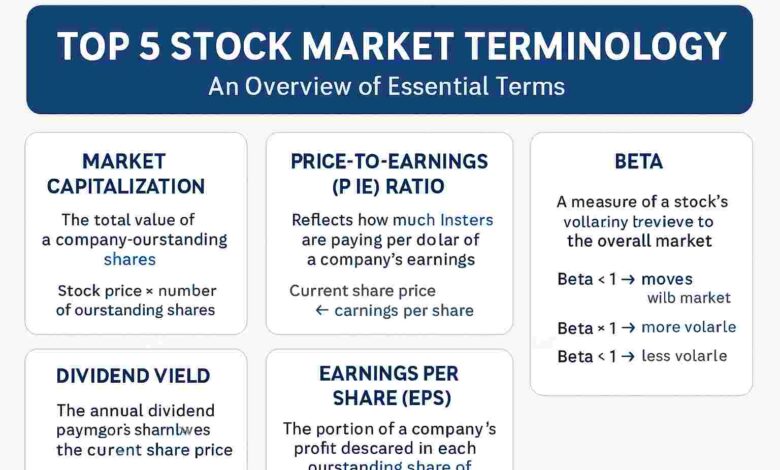Stock Market Terminology: Master the Language of Trading for Success
Understanding Key Terms to Boost Your Financial Knowledge

Introduction
The world of investing can feel overwhelming, especially for beginners who are just getting started in trading and financial markets. Stock market terminology plays a vital role in understanding how trading works and making informed decisions. Without grasping basic stock market terms, it’s easy to get lost in complex financial discussions.
This guide will break down the most essential stock market terms and explain their significance in simple language. By the end of this article, you will not only understand key concepts like market capitalization, P/E ratio, dividend yield, and beta, but you’ll also gain the confidence to navigate the stock market like a pro. Whether you’re a complete beginner or looking to refresh your knowledge, this comprehensive article will help you understand the language of investing.
Quick Fact
The global stock market capitalization is over $100 trillion, making it one of the most powerful drivers of the world economy.
Why Stock Market Terminology Matters
Understanding stock trading terms is like learning a new language. Just as you can’t play a sport without knowing the rules, you can’t invest wisely without knowing the vocabulary.
Many beginners struggle because they don’t understand what analysts, brokers, or news anchors are talking about. Terms like bull market, bear market, EPS, and dividend yield provide insights into market performance and company health. By mastering these financial market terminologies, you will be able to:
-
Make informed investment decisions
-
Analyze company reports and trends
-
Understand market trends and volatility
-
Reduce the risk of financial loss
Top 5 Essential Stock Market Terms
1. Market Capitalization
Definition: Market capitalization, often called market cap, refers to the total value of a company’s outstanding shares.
Formula: Market Cap = Current Share Price × Total Number of Outstanding Shares
Importance:
Market capitalization helps categorize companies:
-
Large-cap stocks: Stable companies with less risk
-
Mid-cap stocks: Balanced risk and growth potential
-
Small-cap stocks: High growth potential but higher risk
Investors use this term to assess the size and stability of a company before buying shares.
2. P/E Ratio (Price-to-Earnings Ratio)
Definition: The P/E ratio measures a company’s current share price compared to its earnings per share (EPS).
Formula: P/E Ratio = Current Share Price ÷ Earnings Per Share
Why It Matters:
-
A high P/E ratio may indicate that investors expect high growth in the future.
-
A low P/E ratio might suggest the stock is undervalued.
This term is essential for value investing and determining whether a stock is overpriced or a bargain.
3. Dividend Yield
Definition: The dividend yield shows how much a company pays out in dividends each year relative to its stock price.
Formula: Dividend Yield = Annual Dividend ÷ Share Price × 100
Why It Matters:
-
Ideal for long-term investing and passive income strategies.
-
High dividend yield stocks are attractive to income-focused investors.
4. Beta
Definition: Beta measures a stock’s volatility compared to the overall market.
-
Beta = 1: Moves with the market
-
Beta > 1: More volatile than the market
-
Beta < 1: Less volatile than the market
Why It Matters:
Investors use beta to assess the risk management of their portfolio. A balanced portfolio may include both high-beta and low-beta stocks to reduce risk.
5. Bull and Bear Markets
Bull Market: A period when stock prices are rising or expected to rise. It represents confidence and growth.
Bear Market: A period when stock prices are falling by 20% or more, indicating fear or pessimism in the market.
Why They Matter:
-
Understanding these terms helps investors plan strategies like buy-and-hold during a bull market or risk management during a bear market.
-
They signal overall market trends and investor sentiment.
Other Key Stock Market Terms You Should Know
-
Bid and Ask Price: The highest price a buyer is willing to pay and the lowest price a seller will accept.
-
Liquidity: How quickly an asset can be converted into cash without affecting its market price.
-
Volatility: The degree of variation in stock prices over time.
-
Portfolio Diversification: Spreading investments across different assets to minimize risk.
-
Swing Trading: Short-term trading strategy to capture small price movements.
-
Value Investing: Buying undervalued stocks with long-term potential.
-
IPO (Initial Public Offering): The first time a company sells shares to the public.
These terms are essential for both beginners and experienced traders to navigate the complexities of the market.
Steps to Learn Stock Market Vocabulary
Start with Basics
Begin by understanding basic stock market terms like shares, dividends, and IPOs. This will create a strong foundation.
Follow Financial News
Regularly read financial reports and articles to see how these terms are used in real-world scenarios.
Practice Through Simulations
Use online trading simulations to practice applying these terms without risking real money.
Conclusion
Mastering stock market terminology is the first step toward becoming a confident and informed investor. From understanding market capitalization to recognizing the signs of a bull or bear market, these terms provide a solid foundation for making smart financial decisions.
By learning these terms and their significance, you will reduce risks, identify profitable opportunities, and develop a deeper understanding of market dynamics. Whether you are a beginner or an experienced trader, the language of the stock market is your key to financial growth and success.
FAQ
Q1: What is the most important stock market term for beginners?
The most important term for beginners is market capitalization, as it helps you understand the size and stability of a company.
Q2: How can I quickly learn stock trading terms?
Start with online tutorials, financial news, and practice on stock market simulation apps.
Q3: What is the difference between a bull and bear market?
A bull market represents rising prices and optimism, while a bear market signals falling prices and fear among investors.
Q4: Why is P/E ratio important for investing?
The P/E ratio helps determine if a stock is overvalued or undervalued, guiding your investment decisions.
Q5: What does dividend yield indicate?
Dividend yield shows the return on investment through dividends, making it crucial for income-focused investors.




